V sign
The V sign is a hand gesture in which the index and middle fingers are raised and parted to make a V shape while the other fingers are clenched. It has various meanings, depending on the circumstances and how it is presented.
When displayed with the palm inward toward the signer, it can be an offensive gesture in some Commonwealth nations, dating back to at least 1900. The more widespread use as a victory sign ("V for Victory"), with the back of the hand toward the signer (U+270C ✌ VICTORY HAND in Unicode), was introduced in January 1941 as part of a campaign by the Allies of World War II. During the Vietnam War, in the 1960s, the "V sign" was widely adopted by the counterculture as a symbol of peace. Shortly thereafter, it also became a gesture associated with fun used in photographs, especially in East Asia, where the gesture is also associated with cuteness.
Origins
A commonly repeated legend claims that the two-fingered salute or V sign derives from a gesture made by longbowmen fighting in the English archers at the Battle of Agincourt (1415) during the Hundred Years' War, but no written historical primary sources support this contention. This origin legend states that English archers believed that those who were captured by the French had their index and middle fingers cut off so that they could no longer operate their longbows, and that the V sign was used by uncaptured and victorious archers in a display of defiance against the French. In conflict with this origin myth, the chronicler Jean de Wavrin, contemporary of the battle of Agincourt, reported that Henry V mentioned in a pre-battle speech that the French were said to be threatening to cut off three fingers (not two) from captured English bowmen. Wielding an English longbow is best done with three fingers. Neither Wavrin nor any contemporary author reported the threat was ever carried out after that nor other battles, nor did they report anything concerning a gesture of defiance.
The first unambiguous evidence of the use of the insulting V sign in the United Kingdom dates to 1901, when a worker outside Parkgate ironworks in Rotherham used the gesture (captured on the film) to indicate that he did not like being filmed.
Peter Opie interviewed children in the 1950s and observed in The Lore and Language of Schoolchildren (1959) that the much-older thumbing of the nose (cocking a snook) had been replaced by the V sign as the most common insulting gesture used in the playground.
Between 1975 and 1977, a group of anthropologists including Desmond Morris studied the history and spread of European gestures and found the rude version of the V-sign to be basically unknown outside the British Isles. In his Gestures: Their Origins and Distribution, published in 1979, Morris discussed various possible origins of this sign but came to no definite conclusion:
- because of the strong taboo associated with the gesture (its public use has often been heavily penalised). As a result, there is a tendency to shy away from discussing it in detail. It is "known to be dirty" and is passed on from generation to generation by people who simply accept it as a recognised obscenity without bothering to analyse it... Several of the rival claims are equally appealing. The truth is that we will probably never know...
Victory sign
Second World War: V for Victory campaign
On 18 May 1939, the French daily, Le Monde Quotidien had a headline of, 'V pour victoire'. On 14 January 1941, Victor de Laveleye, former Belgian Minister of Justice and director of the Belgian French-language broadcasts on the BBC (1940–44), suggested in a broadcast that Belgians use a V for victoire (French: "victory") and vrijheid (Dutch: "freedom") as a rallying emblem during the Second World War.
In the BBC broadcast, de Laveleye said that "the occupier, by seeing this sign, always the same, infinitely repeated, [would] understand that he is surrounded, encircled by an immense crowd of citizens eagerly awaiting his first moment of weakness, watching for his first failure." Within weeks chalked up Vs began appearing on walls throughout Belgium, the Netherlands and Northern France.[30] Buoyed by this success, the BBC started the "V for Victory" campaign, for which they put in charge the assistant news editor Douglas Ritchie posing as "Colonel Britton". Ritchie suggested an audible V using its Morse code rhythm (three dots and a dash). As the rousing opening bars of Beethoven's Fifth Symphony had the same rhythm, the BBC used this as its call-sign in its foreign language programmes to occupied Europe for the rest of the war. The more musically educated also understood that it was the Fate motif "knocking on the door" of the German Third Reich. The BBC also encouraged the use of the V gesture introduced by de Laveleye.
By July 1941, the emblematic use of the letter V had spread through occupied Europe. On 19 July, Prime Minister Winston Churchill referred approvingly to the V for Victory campaign in a speech, from which point he started using the V hand sign. Early on he sometimes gestured palm in (sometimes with a cigar between the fingers). Later in the war, he used palm out. After aides explained to the aristocratic Churchill what the palm in gesture meant to other classes, he made sure to use the appropriate sign. Yet the double-entendre of the gesture might have contributed to its popularity, "for a simple twist of hand would have presented the dorsal side in a mocking snub to the common enemy". Other allied leaders used the sign as well.
The Germans could not remove all the signs, so they adopted the V Sign as a German symbol, sometimes adding laurel leaves under it, painting their own V's on walls, vehicles and adding a massive V on the Eiffel Tower.
Chat rooms • What links here • Copyright info • Contact information • Category:Root
